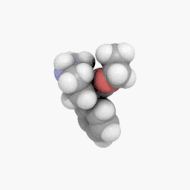去甲哌替啶
去甲哌替啶是一种4-苯基哌啶的衍生物,化学式为C14H19NO2。它是哌替啶的前体及有毒代谢物。它被列入联合国麻醉品单一公约,也被美国列入到受管制物质法案附表II,2014年的生产限额为11克(0.39盎司)。[1]
 | |
 | |
| 臨床資料 | |
|---|---|
| 给药途径 | N/A |
| ATC碼 |
|
| 法律規範狀態 | |
| 法律規範 |
|
| 识别 | |
| |
| CAS号 | 77-17-8 |
| PubChem CID | |
| ChemSpider | |
| UNII | |
| KEGG | |
| ChEMBL | |
| CompTox Dashboard (EPA) | |
| ECHA InfoCard | 100.000.918 |
| 化学 | |
| 化学式 | C14H19NO2 |
| 摩尔质量 | 233.31 g·mol−1 |
| 3D模型(JSmol) | |
| |
| |
去甲哌替啶因可用于合成哌替啶及相关的N-取代衍生物(如依托利定[2]、苄替啶[3]、呋替啶[4])而受到管制。不过,去甲哌替啶本身的类阿片作用低,是一种引起抽搐的兴奋剂。[5][6]
当把哌替啶用作镇痛药时,就要大剂量使用[7]或静脉注射哌替啶。[8]这会去甲哌替啶产生的速率比排泄去甲哌替啶的速率快,导致去甲哌替啶累积产生的并发症,包括抽搐、肌阵挛[9]、低血钠症。[10]这些并发症可能会很严重,甚至可能导致死亡。[11]这些并发症在老年人[12]及肝功能或肾功能受损的人[13]身上更明显。
哌替啶在体内会被肝脏属于细胞色素P450的CYP2B6、CYP2C19、CYP3A4代谢成去甲哌替啶。由于这些酶的活性因人而异,且可能受到共服的其它药物影响,因此很难预测产生去甲哌替啶的速率。[14][15]
参考资料
- . Diversion Control Division. Drug Enforcement Administration (DEA), U.S. Department of Justice.
- US granted 2858316,Henri M,「New piperidine derivatives」,发表于28 October 1958,指定于UCB SA
- Frearson PM, Stern ES. . Journal of the Chemical Society (Resumed). 1958: 3065–7. doi:10.1039/JR9580003065.
- Frearson PM, Hardy DG, Stern ES. . Journal of the Chemical Society (Resumed). 1960: 2103–7. doi:10.1039/JR9600002103.
- Umans JG, Inturrisi CE. . The Journal of Pharmacology and Experimental Therapeutics. October 1982, 223 (1): 203–6. PMID 7120119.
- Plummer JL, Gourlay GK, Cmielewski PL, Odontiadis J, Harvey I. . Toxicology. January 1995, 95 (1–3): 37–44. PMID 7825188. doi:10.1016/0300-483x(94)02871-q.
- Simopoulos TT, Smith HS, Peeters-Asdourian C, Stevens DS. . Archives of Surgery (Chicago, Ill.). January 2002, 137 (1): 84–8. PMID 11772223. doi:10.1001/archsurg.137.1.84
 .
. - Stone PA, Macintyre PE, Jarvis DA. . British Journal of Anaesthesia. November 1993, 71 (5): 738–40. PMID 8251291. doi:10.1093/bja/71.5.738
 .
. - Reutens DC, Stewart-Wynne EG. . Journal of Neurology, Neurosurgery, and Psychiatry. December 1989, 52 (12): 1450–1. PMC 1031622
 . PMID 2614458. doi:10.1136/jnnp.52.12.1450.
. PMID 2614458. doi:10.1136/jnnp.52.12.1450. - Appel WC. . Canadian Medical Association Journal. November 1987, 137 (10): 912–3. PMC 1267380
 . PMID 3676934.
. PMID 3676934. - Jiraki K. . The American Journal of Forensic Medicine and Pathology. March 1992, 13 (1): 42–3. PMID 1585886. S2CID 32005631. doi:10.1097/00000433-199203000-00009.
- Holmberg, L.; Odar-Cederlöf, I.; Boréus, L. O.; Heyner, L.; Ehrnebo, M. . European Journal of Clinical Pharmacology. 1982, 22 (2): 175–179. ISSN 0031-6970. doi:10.1007/BF00542464.
- Pond SM, Tong T, Benowitz NL, Jacob P, Rigod J. . Clinical Pharmacology and Therapeutics. August 1981, 30 (2): 183–8. PMID 7249503. S2CID 10117158. doi:10.1038/clpt.1981.146.
- Ramírez J, Innocenti F, Schuetz EG, Flockhart DA, Relling MV, Santucci R, Ratain MJ. . Drug Metabolism and Disposition: The Biological Fate of Chemicals. September 2004, 32 (9): 930–6. PMID 15319333.
- McHugh GJ. . Anaesthesia and Intensive Care. June 1999, 27 (3): 289–91. PMID 10389564.
Template:Navbox with collapsible groups
This article is issued from Wikipedia. The text is licensed under Creative Commons - Attribution - Sharealike. Additional terms may apply for the media files.